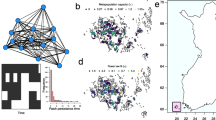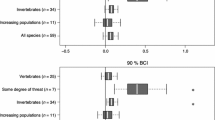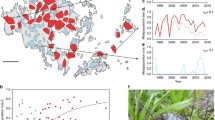Abstract
Metapopulations are conceived as spatially structured populations consisting of distinct units (subpopulations), separated by space or barriers, and connected by dispersal movements. Metapopulations characteristically demonstrate a turnover of local populations going extinct and becoming re-established, resulting in a distribution pattern that shifts over time. Metapopulation theory is used to analyse the effects of habitat fragmentation on birds in the temperate zone, integrating various explanations for the paucity of species in isolated ecotopes.
There is some evidence that turnover of local populations occurs in fragmented systems. A few studies based on time series demonstrate the local extinction rate to be related to the size of the habitat fragment, whereas the recolonization rate depends on the degree of isolation. Most evidence comes from short-term pattern studies in which the probability of occurrence was found to depend on the size of habitat fragments, on their relative position in the landscape and on the density of corridors lowering the landscape resistance. These data are consistent with predictions from metapopulation theory. However, almost all investigations consider wood fragmentation in agricultural landscapes, and there is a great need for studies in naturally fragmented landscapes as well as for studies focussing on other, less predictable, habitat types.
Similar content being viewed by others
References
Ambuel, B. and Temple, S.A. 1983. Area-dependent changes in the bird communities and vegetation of southern Wisconsin forest. Ecology 64: 1057–1068.
Andrèn, H., Angelstam, P., Lindström, P. and Widèn, P. 1985. Differences in predation pressure in relation to habitat fragmentation: an experiment. Oikos 45: 273–277.
Andrèn, H. and Angelstam, P. 1988. Elevated predation rates as an edge effect in habitat islands: experimental evidence. Ecology 69: 544–547.
Andrewartha, H.G. and Birch, L.C. 1954. The distribution and abundance of animals. University of Chicago Press, Chicago.
Anselin, A. and Meire, P.M. 1986. Breeding bird communities of reed marshes in Northwest Flanders. Biol. Jb. Dodonaea 54: 174–186.
Askins, R.A., Philbrick, M.J. and Sugeno, D.S. 1987. Relationship between the regional abundance of forest and the composition of forest bird communities. Biol. Conserv. 39: 129–152.
Askins, R.A. and Philbrick, M.J. 1987. Effects of changes in regional forest abundance on the decline and recovery of a forest bird community. Wilson Bull. 99: 7–21.
Berndt, R. and Sternberg, H. 1968. Terms, studies and experiments on the problems of bird dispersion. IbisWilson Bull. 110: 256–269.
Blake, J.G. and Karr, J.R. 1987. Breeding birds of isolated woodlots: area and habitat relationships. Ecology 68: 1724–1734.
Brittingham, M.C. and Temple, S.A. 1983. Have cowbirds caused forest songbirds to decline? BioScience 33: 31–35.
Brown, M. and Dinsmore, J. 1986. Implications of marsh size and isolation for marsh bird management. J. Wild. Manage 50: 392–397.
Brown, J.H. and Kodric-Brown, A. 1977. Turnover rates in insular biogeography: effect of immigration on extinction. Ecology 58: 445–449.
Burkey, T.V. 1989. Extinction in nature reserves: the effect of fragmentation and the importance of migration between reserve fragments. Oikos 55: 75–81.
Butcher, G.S., Niering, W.A., Barry, W.J. and Goodwin, R.H. 1981. Equilibrium biogeography and the size of nature preserves. An avian case study. Oecologia 49: 29–37.
Cieślak, M. 1985. Influence of forest size and other factors on breeding bird species number. Ekologia Polska 33: 103–121.
Decamps, H.J., Joachim, J. and Lauga, J. 1987. The importance for birds of the riparian woodlands within the alluvial corridor of the river Garonne, S.W. France. In Regulated Rivers: research and management, Vol. 1. pp. 301–316. J. Wiley & Sons, New York.
Delius, J.D. 1965. A population study of skylarks Alauda arvensis.Regulated Rivers: research and management 107: 466–491.
Den Boer, P.J. 1981. On the survival of populations in a heterogeneous and variable environment. Oecologia 50: 39–53.
Diamond, J.M. 1984. ‘Normal’ extinctions of isolated populations. In Extinctions. pp. 191–246. Edited by M.H. Nitecki. University of Chicago Press.
Dickman, C.R. 1987. Habitat fragmentation and vertebrate species richness in an urban environment. J. Appl. Ecol. 24: 337–351.
Eden, S.F. 1987. Natal philopatry of the magpie Pica pica.J. Appl. Ecol. 129: 477–490.
Enoksson, B. 1987. Local movements in the Nuthatch Sitta europaea. Acta Reg. Soc. Sci. Litt. Gothoburgensis Zoologica 14: 36–47.
Ford, H.A. 1987. Bird communities on habitat islands in England. Bird study 34: 205–218.
Forman, R.T.T., Galli, A.E. and Leck, C.F. 1976. Forest size and avian diversity in New Jersy woodlots with some landuse implications. Oecologia 26: 1–8.
Forman, R.T.T. and Godron, M. 1986. Landscape Ecology. John Wiley & Sons, New York.
Freemark, K.E. and Merriam, H.G. 1986. Importance of area and habitat heterogeneity to bird assemblages in temperate forest fragments. Biol. Conserv. 36: 115–141.
Fritz, R.S. 1979. Consequences of Insular Population structure. Distribution and Extinction of Spruce Grouse populations. Oecologia 42: 57–65.
Gauthreaux, S.A. 1982. The ecology and evolution of avian migration systems. In Avian Biology, Vol. VI. pp. 93–168. Edited by D.S. Farner et al. Academic Press, New York.
Gates, J.E. and Gysel, L.W. 1978. Avian nest dispersion and fledging success in field-forest ecotones. Ecology 59: 871–883.
Gotfryd, A. and Hansell, R.I.C. 1986. Prediction of birdcommunity metrics in urban woodlots. In Wildlife 2000. Modelling habitat relationships of terrestrial vertebrates. pp. 321–326. Edited by J. Verner, M.L. Morrison and C. Ralph. Univ. Wisconsin Press, Madison.
Greenwood, P.J. and Harvey, P.H. 1976. The adaptive significance of variation in breeding area fidelity of the blackbird (Turdus merula L.). J. Anim. Ecol. 45: 887–891.
Greenwood, P.J. and Harvey, P.H. 1982. The natal and breeding dispersal of birds. Ann. Rev. Ecol. Syst. 13: 1–21.
Hanski, I. 1989. Metapopulation dynamics: does it help to have more of the same? TREE 4: 113–114.
Harms, W.B. and Opdam, P. 1989. Woods as habitat patches for birds: application in landscape planning in the Netherlands. In Changing landscapes: an ecological perspective. pp. 73–97. Edited by I.S. Zonneveld and R.T.T. Forman. Springer Verlag, New York.
Harrison, S., Murphy, D.D. and Ehrlich, P.R. 1988. Distribution of the bay checkerspot butterfly, Euphydras editha bayensis: evidence for a metapopulation model. American Naturalist 132: 360–382.
Hastings, A. and Wolin, C.L. 1989. Within-patch dynamics in a metapopulation. Ecology 70: 1261–1266.
Hayden, I.J., Faaborg, J. and Clawson, R.L. 1985. Estimates of minimum area requirements for Missouri forest birds. Transactions Missouri Academy of Science 19: 11–22.
Helliwell, D.R. 1976. The effects of size and isolation on the conservation value of wooded sites in Britain. J. Biogeogr. 3: 407–416.
Hengeveld, R. 1990. Dynamic Biogeography. Cambridge University Press, Cambridge.
Howe, R.W. 1984. Local dynamics of bird assemblages in small forest habitat islands in Australia and North America. Ecology 65: 1585–1601.
Karr, J.R. 1982. Population variability and extinction in the avifauna of a tropical land bridge island. Ecology 63: 1975–1978.
Kitchener, D.J., Chapman, A., Dell, J., Muir, B.G. and Palmer, M. 1980. Lizard assemblages and reserve size and structure in the Western Australian wheatbelt - some implications for conservation. Biol. Conserv. 17: 25–62.
Leigh, E.G. 1981. The average lifetime of a population in a varying environment. J. Theor. Biol. 90: 213–239.
Levins, R. 1970. Extinctions. In Some Mathematical Questions in Biology, Vol. 2. pp. 77–107. Lectures on Mathematics in the Life Sciences. Amer. Math. Soc., Providence, Rhode Island.
Lynch, J.F. and Whigham, D.F. 1984. Effects of forest fragmentation on breeding bird communities in Maryland, USA. Biol. Conserv. 28: 287–324.
Martin, Th. E. 1981. Species-area slopes and coefficients: a caution on their interpretation. Amer. Nat. 118: 823–837.
Matthysen, E. and Schmidt, K.-H. 1987. Natal dispersal in the nuthatch. Orn. Scand. 18: 313–316.
McCoy, E.D. 1983. The application of island-biogeographic theory to patches of habitat: how much land is enough? Biol. Conserv. 25: 53–62.
Merriam, G. 1988. Landscape dynamics in farmland. TREE 3: 16–20.
Moore, N.W. and Hooper, M.D. 1975. On the number of bird species in British woods. Biol. Conserv. 8: 239–250.
Müller, W. 1982. Die Besiedlung der Eichenwälder im Kanton Zürich durch den Mittelspecht, Dendrocopus medius. Orn. Beob. 79: 105–119.
Murphy, D.D. and Wilcox, B.A. 1986. Butterfly diversity in natural habitat fragments: A test of the validity of vertebratebased management. In Wildlife 2000. Modeling Habitat Relationships of Terrestrial Vertebrates. pp. 287–292. Edited by J. Verner, J.L. Morrison and C. Ralph. University of Wisconsin Press, Madison.
Opdam, P., Van Dorp, D. and Ter Braak, C.J.F. 1984. The effect of isolation on the number of woodland birds of small woods in The Netherlands. J. Biogeogr. 11: 473–478.
Opdam, P., Rijsdijk, G. and Hustings, F. 1985. Bird communities in small woods in an agricultural landscape: Effects of area and isolation. Biol. Conserv. 34: 333–352.
Opdam, P. 1987. De metapopulatie, model van een populatie in een versnipperd landschap. Landschap 4: 289–306.
Opdam, P. 1988. Populations in fragmented landscape. In Connectivity in Landscape Ecology. Edited by K.F. Schreiber. Proc. 2nd. Int. Sem. IALE. Münstersche Geographische Arbeiten 29: 75–77.
Opdam, P. 1990a. Dispersal in fragmented populations: the key to survival. In Species dispersal in agricultural habitat. pp. 3–17. Edited by R.G.H. Bunce and D.C. Howard. Belhaven Press, London.
Opdam, P. 1990b. Understanding the ecology of populations in fragmented landscapes. Proc. XIX IUGB-Congress, Trondheim (in press).
Pettersson, B. 1985. Relative importance of habitat area, isolation and quality for the occurrence of middle spotted woodpecker Dendrocopos medius (L.) in Sweden. Hol. Ecology 8: 53–58.
Reichholf, J. 1984. Inselökologische Aspekte der Ausweisung von Naturschutzgebieten für die Vogelwelt. In Inselökologie-Andwendung in der Planung des Landlichen Raums. pp. 57–61. Edited by H.J. Mader. Laufener Seminarbeitrage 7/84.
Sillen, P. and Solbreck, C. 1977. Effect of area and habitat diversity on bird species richness in lakes. Ornis Scand. 8: 185–192.
Simberloff, D. 1988. The contribution of population and community biology to conservation science. Ann. Rev. Ecol. Syst. 19: 473–511.
Small, M.F. and Hunter, M.L. 1988. Forest fragmentation and avian nest predation in forested Landscapes. Oecologia 76: 62–64.
Soulé, M.E. and Simberloff, D.S. 1986. What do genetics and ecology tell us about the design of nature reserves? Biol. Conserv. 35: 19–40.
Soulé, M.E., Bolger, D.T., Alberts, A.C. et al. 1988. Reconstructed dynamics of rapid extinctions of chaparral-requiring birds in urban habitat islands. Conservation Biology 2: 75–92.
Urban, D.L. and Shugart Jr. H.H. 1986. Avian Demography in Mosaic landscapes: Modeling Pradigm and Preliminary Results. In Wildlife 2000. Modeling Habitat Relationships of Terrestrial Vertebrates. pp. 273–279. Edited by J. Verner et al. University of Wisconsin Press, Madison.
Van Dorp, D. and Opdam, P.F.M. 1987. Effects of patch size, isolation and regional abundance on forest bird communities. Landscape Ecology 1: 59–73.
Van Noorden, B. 1986. Dynamiek en dichtheid van bosvogels in geïsoleerde loofbosfragmenten. RIN-rapport 86/19, Leersum.
Vizyová, A. 1985. Urban woodlots as islands for land vertebrates: a preliminary attempt on estimating the barrier effects of urban structural units. 7th International Symposium on Problems of Landscape Ecological Research, Bratislava.
Whitcomb, R.F., Robbins, C.S., Lynch, J.F., Whitcomb, B.L., Klimhiewicz, M.K. and Bystrak, D. 1981. Effects of forest fragmentation on avifauna of the eastern deciduous forest. In Forest island dynamics in man-dominated landscapes. pp. 125–206. Edited by R.L. Burgess and D.M. Sharpe. Springer, New York.
Wiens, J.A. 1989. The Ecology of Bird Communities. Vol. 2. Processes and variations. Cambridge University Press, Cambridge.
Wilcove, D.S. 1985. Nest predation in forest tracts and the decline of migratory songbirds. Ecology 66: 1211–1214.
Wilcove, D.S., McLellan, C.H. and Dobson, A.P. 1986. Habitat fragmentations in the temperate zone. In Conservation biology. The science of scarcity and diversity. pp. 237–256. Edited by M.E. Soulé. Sinauer Ass., Sunderland.
Williams, C.B. 1964. Patterns in the balance of nature. Academic Press, New York.
Author information
Authors and Affiliations
Rights and permissions
About this article
Cite this article
Opdam, P. Metapopulation theory and habitat fragmentation: a review of holarctic breeding bird studies. Landscape Ecol 5, 93–106 (1991). https://doi.org/10.1007/BF00124663
Issue Date:
DOI: https://doi.org/10.1007/BF00124663




